O's Summer Beauty Survival Handbook
Bugs are biting, the sun is burning, your hair is expanding. For every problem—even the worst-case scenarios—we've found you the best solutions.
By Jenny Bailly

Photo: Fernando Milani
How to Cut a Sunburn Short
As soon as you notice you're toasted, take this four-pronged approach:
1. Pop two aspirin, which inhibits the prostaglandin release that can increase redness.
2. Take a cool bath or shower. A sunburn increases blood flow to your skin; cold water reduces it.
3. Slather the affected areas with an aloe gel, like Aubrey Organics 100% Pure Aloe Vera Gel. Avoid aloe products that contain alcohol, which can dry skin and increase peeling.
4. Solemnly swear to always apply sunscreen (and reapply, every two hours) when you're in the sun.

Illustration by Peter Arkle
How to Treat a Mosquito Bite (in the Middle of Your Forehead)
Dab a 1 percent hydrocortisone ointment on the bump as soon as you notice it to bring down the inflammation and redness. (If you're willing to pop a pill, an antihistamine, like Zyrtec, will also help reduce swelling.) Once you've treated the bite, cover it as you would a pimple. Here's makeup artist Troy Surratt's strategy:
- Use a small synthetic makeup brush to dab creamy concealer over the bite. Brush the concealer up and down and side to side so it blends into the skin.
- Pat the concealer with your ring finger a couple of times to remove any excess.
- Take a sponge wedge and dab on a translucent powder to set the concealer.
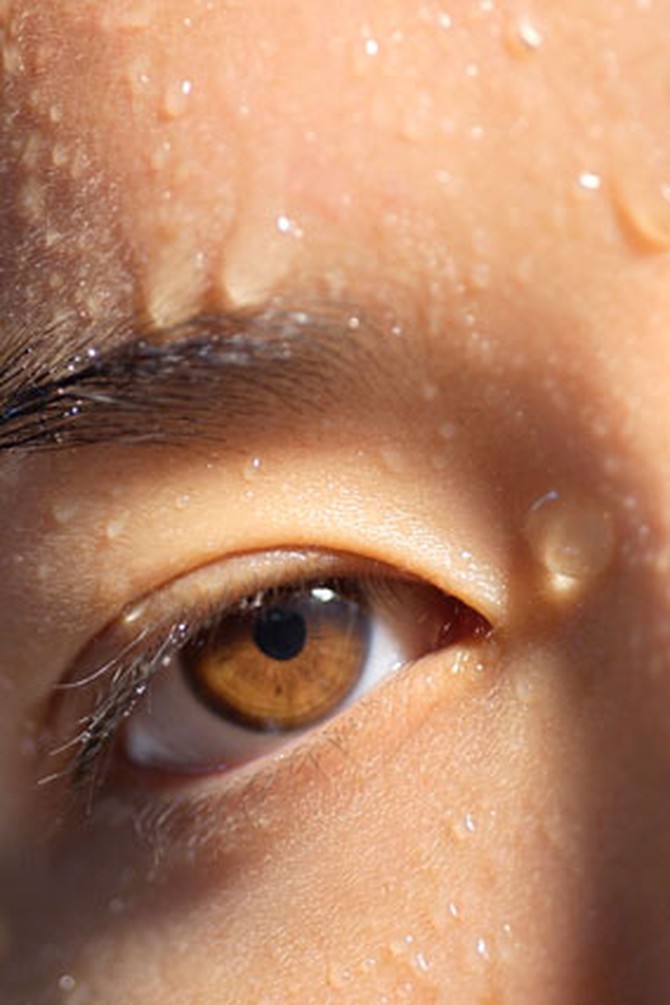
Photo: Thinkstock
How to Sweat Less (or Appear to)
A cold shower doesn't just temporarily cool you down. "It lowers your skin temperature and can actually reregulate how much you sweat," says Loretta Ciraldo, MD, voluntary professor of dermatology at the University of Miami Miller School of Medicine. Post-shower, towel off and sprinkle powder (like Zeasorb Super Absorbent Powder) over areas that tend to be particularly sweaty. If your feet get slippery in summer, use the cool setting on your hair dryer to dry them completely, then pat powder on them (don't miss between your toes). And consider upping your antiperspirant power. Secret Clinical Strength and Degree Clinical Protection contain the highest over-the-counter concentrations of an effective sweat-duct-blocking ingredient (aluminum zirconium tetrachlorohydrex glycine, FYI). For the best results, apply antiperspirant to totally dry skin before bed. If you need even-more-potent sweat prevention, ask your dermatologist for a prescription antiperspirant, like Xerac AC or Drysol. And if you're a bucket sweater, there's always Botox. Underarm injections can cost up to $3,000, but you'll stay dry for at least three—and up to seven—months.
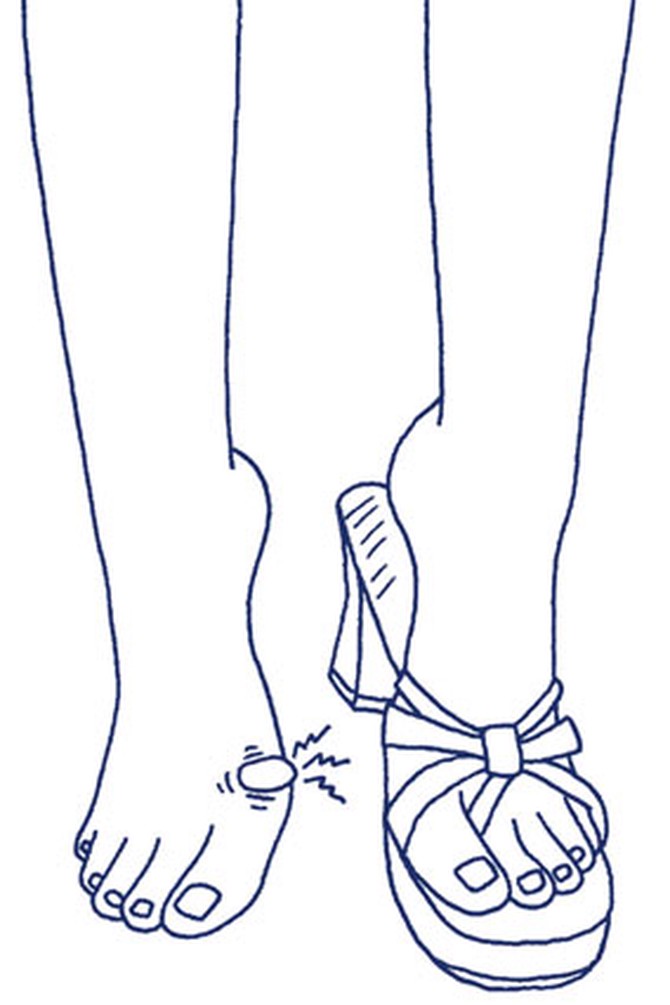
Illustration by Peter Arkle
How to Treat a Killer Blister
To pop, or not to pop, that is the question. The dermatologists we spoke with answered: Pop.
"The blister will heal more readily if you drain it yourself than if it rips open later," says Jeffrey Benabio, MD, a dermatologist for Kaiser Permanente in San Diego. Sterilize a needle (by dipping it in rubbing alcohol or holding it in a flame) and use it to make a tiny puncture hole in the blister. Let the liquid (it's just water) drain out, then cover with a Band-Aid. Change the Band-Aid daily, until the skin has healed. And in the meantime, don't wear shoes that could irritate the spot.
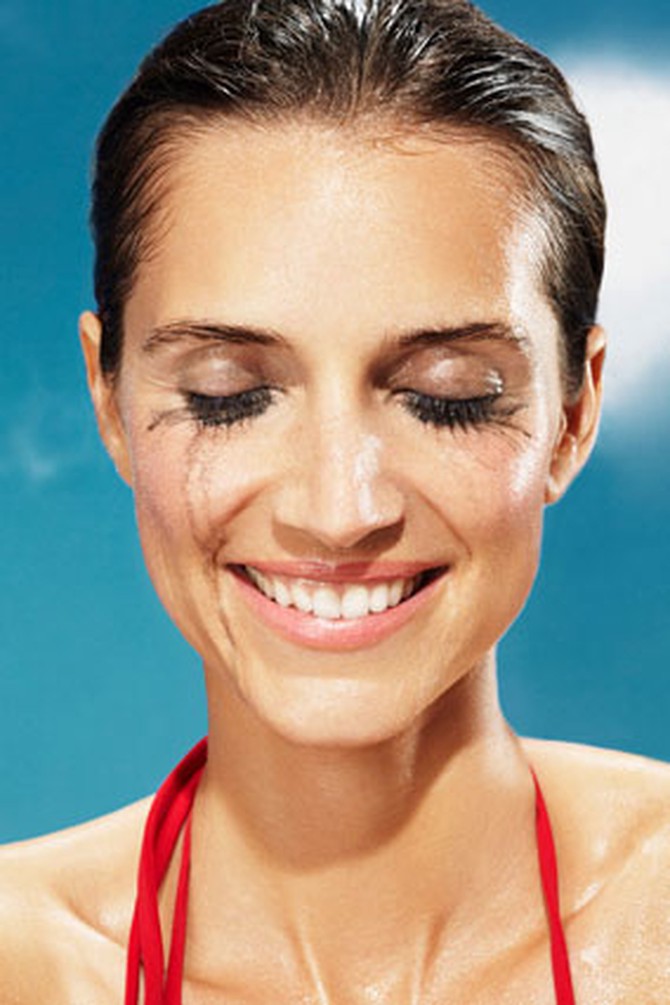
Photo: Fernando Milani
How to Keep Your Makeup From Running
Is your instinct to wear less makeup in the heat? Congratulations, your instinct is right! You can still look polished, though, with this pared-down routine from makeup artist Tracy Murphy.
To even out your complexion in summer, use a moisturizer with gradual self-tanner and SPF (like Jergens Natural Glow Healthy Complexion Daily Facial Moisturizer with SPF 20).
Minimize undereye circles and blemishes with a waterproof concealer, like Lancôme Effacernes.
Powdery makeup and perspiration are not a pretty combination; swap your powder blush for a cheek stain (like Benefit ChaChaTint).
Eyeshadow can be ephemeral in the heat, so retire it until fall. Define your eyes with a waterproof liquid liner (like Make Up For Ever Aqua Liner) and waterproof mascara (like NYC New York Color Show Time Volumizing Mascara).
Play up your mouth with a smear-proof lip stain or waxy tinted balm. (Try Smashbox Limitless Lip Stain & Color Seal Balm, or Fresh Sugar Honey Tinted Lip Treatment SPF 15).

Illustration by Peter Arkle
How to Treat Poison Ivy
(or Oak, or Sumac)
(or Oak, or Sumac)
Quick! Grab a bar of soap and wash off that nasty urishiol (the oil found on these poisonous plants). If you act within ten minutes, you can get rid of 50 percent of the rash-inducing substance, says dermatologist Benabio. Within 30 minutes, you can still rinse away about 10 percent. After a couple of hours, unfortunately, you'll probably be stuck with a rash for about two weeks. (The good news: After an hour or so, the oil—and the itchy rash—can't spread.) When blisters form, an astringent soak like Domeboro can help dry them. Once the blisters are gone, take cool baths with colloidal oatmeal (try Aveeno Soothing Bath Treatment) and apply a hydrocortisone cream to minimize itching. Next time you might be exposed to poison ivy (and the chances keep increasing—ever-higher levels of carbon dioxide in the air are causing a boom in the toxic plants), rub on IvyBlock before you go outside.
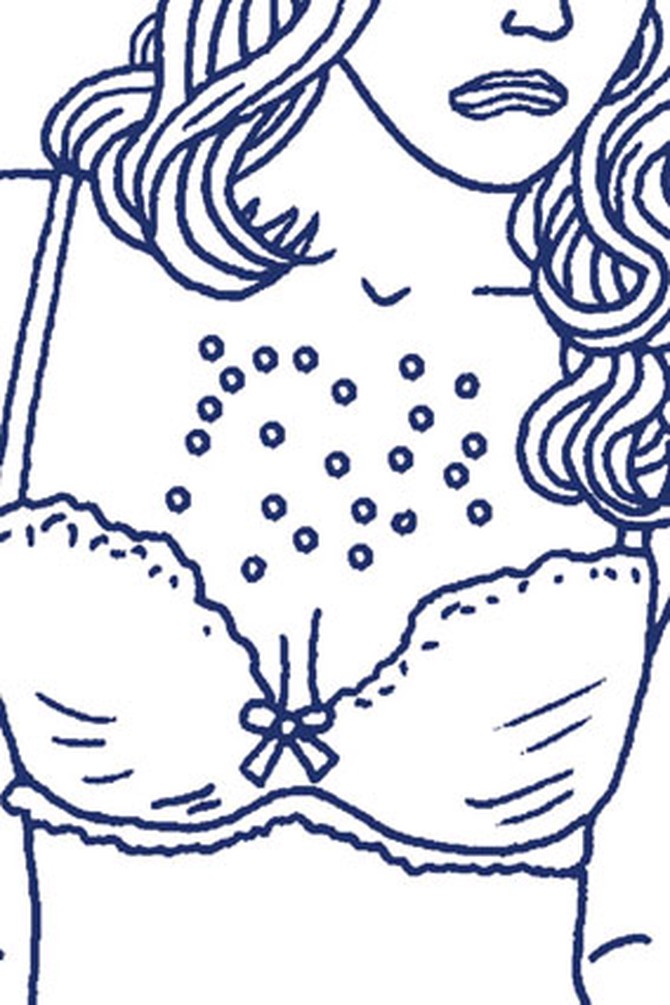
Illustration by Peter Arkle
How to Deal With a Breakout
on Your Chest
on Your Chest
For individual pimples, dab on a concentrated concealer with a fine-pointed makeup brush. Body makeup can look thick on the chest and back, so choose a face formula instead. Makeup artist Surratt loves Kevyn Aucoin Sensual Skin Enhancer—it comes in 16 shades, and a little goes a long way. Use a translucent powder to set the concealer.
For more diffuse breakouts, apply a powder foundation (like Stila Illuminating Powder Foundation, or Revlon ColorStay Aqua Mineral Makeup) all over the offending area with a large fluffy brush.

Photo: Thinkstock
How to Prevent Fine Hair From Wilting
Oil is your enemy. Shampoo daily to get rid of the grease that can weigh down hair at the roots; dermatologist Ciraldo loves Neutrogena T/Sal shampoo for oil control. And go easy on conditioner; hairstylist Eva Scrivo recommends using one with a gel consistency (like KMS California Add Volume Gel Conditioner) to keep hair smooth without flattening it. To defy gravity all day, look for products billed as "root lifters" (like L'Oréal Paris Studio Line Pumping Volume Spritz). Spray at the roots when hair is still damp. For extra volume, flip your head upside down while you blow-dry.
How to Get Your Hair Off Your Neck:
Add polish to the easiest solution—a ponytail—by creating a clean side part first. Have a little more time? Twist the tail into a chignon and anchor it with ridged bobby pins. Or twirl the tail until it coils back on itself and tuck the ends into the elastic. The finished effect: informal elegance.

Photo: Fernando Milani
How to Keep Your Frizz
Under Control
Under Control
Even hair that's perfectly obedient the rest of the year can mutiny on a summer day. As moisture in the air permeates the hair strands, they expand...and expand...and suddenly the style you left the house with has tripled in size. Start controlling the situation in the shower. Shampoos and conditioners that contain lightweight silicones help lock down the cuticle of each strand, blocking moisture from entering. (Try Herbal Essences Touchably Smooth Shampoo, and Nexxus Hydra Sleek Silken Smoothing Conditioner.) Continue the cuticle-coating process after you shower: When hair is still very wet, comb through a silicone serum from root to tip (a dime-sized dollop should do). To fight frizz in very curly or kinky hair, look for a thick styling cream that contains not only silicone but also rich moisturizers like honey and wheat protein; apply liberally and distribute with your fingers or a wide-toothed comb. (Try Hair Rules Kinky Curling Cream.) If you want to let your hair air-dry, just keep your hands off for the rest of the day (touching it can induce frizz). If you blow-dry, wait until your hair is just damp, then, aiming the nozzle of the dryer downward, dry in two-inch sections with a large round brush.
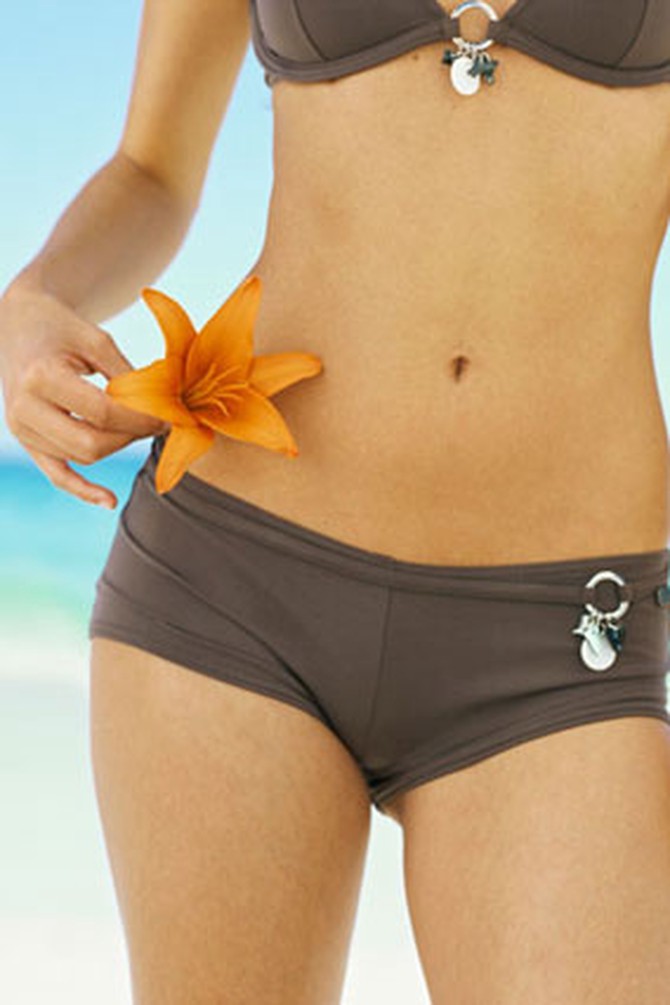
Photo: Thinkstock
How to Get Rid of Bikini-Line Irritation
Those annoying red bumps that crop up after you shave are likely a case of folliculitis, an inflammation of the hair follicle. Unlike many other-itises, this one has wonderfully straightforward solutions. Upgrade your hair-removal tool kit with:
A salicylic acid scrub (like Bioré Pore Unclogging Scrub): Use it on your bikini line two to three times a week (between shaves) to buff away the dead skin that can block hair follicles.
A moisturizing shaving cream: It will soften both your skin and your stubble to make shaving less irritating.
A clean, sharp, razor: Look for one with four blades (you'll get a close shave without pressing too hard), and toss it after a few uses (when it's dulling and may be harboring bacteria).
An antibacterial soap (like Dial): Wash your bikini line with it every day to kill the bacteria that can inflame hair follicles.
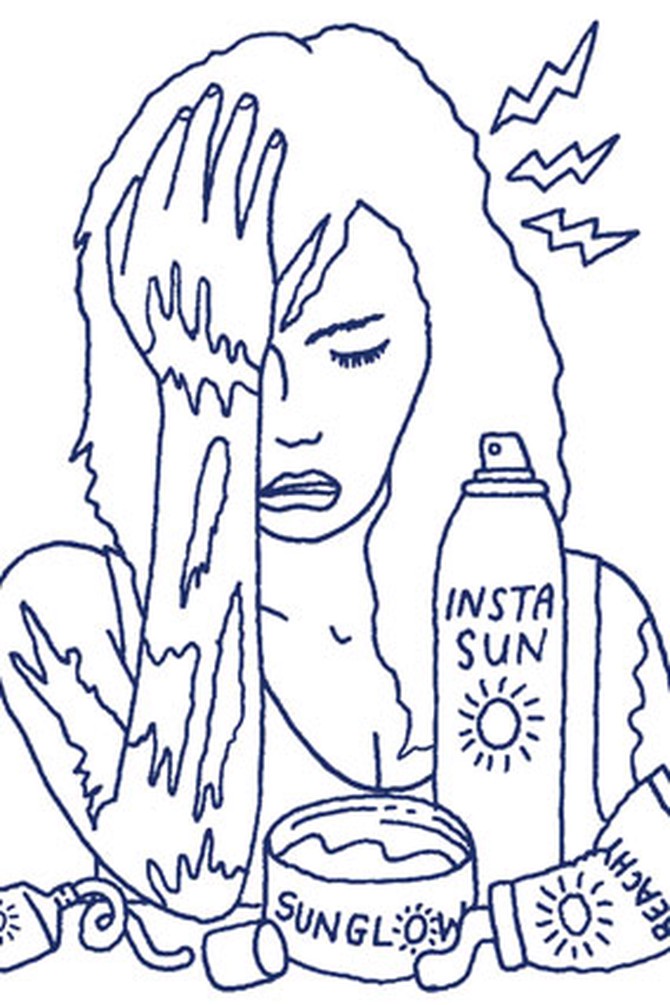
Illustration by Peter Arkle
How to Fix a Self-Tanner Hangover: Streaky Ankles, Stained Palms
Self-tanner reacts with the proteins in the upper layers of your skin to produce a bronze tint, so buffing away that surface skin will soften the color. In the shower, squeeze an exfoliating scrub (preferably one containing glycolic acid, like Dr. Brandt Microdermabrasion Body) onto a loofah and rub it in circles over the darkest areas. If you don't have an exfoliator handy, the citric acid in fresh lemon juice can help slough away excess color. You can even cut a lemon in half and rub it directly on the splotchy areas. Once your skin is dry, a tinted bronzer (which rinses off easily) will help even things out; you can also minimize remaining streaks by applying a subtle gradual tanner (like Lorac SelfTantalizer Body Bronzing Gradual Self-Tanner) all over. And next time, exfoliate thoroughly before applying self-tanner; when you're done applying, gently rub a damp washcloth over your elbows, knees, ankles, and feet (the areas most likely to streak).
From the August 2011 issue of O, The Oprah Magazine

